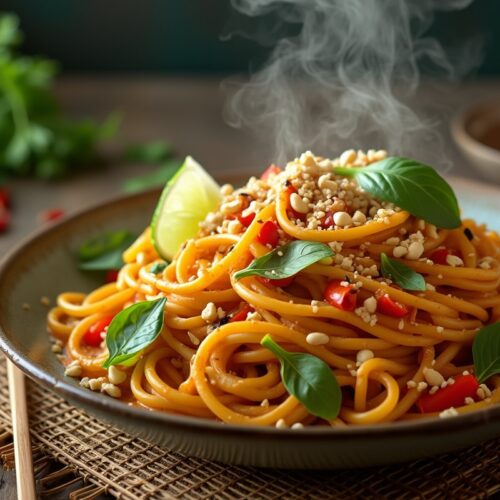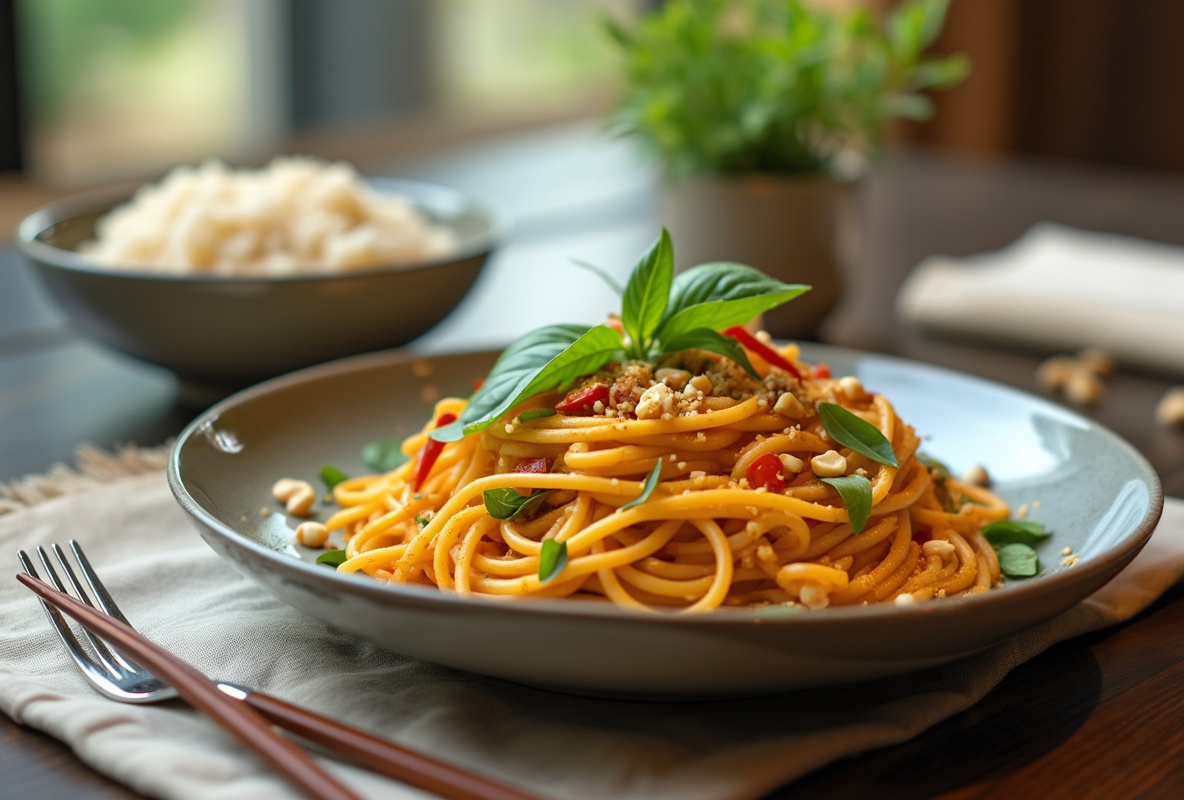Understanding the Basics of Thai Cuisine
When it comes to discovering the vibrant world of Thai cuisine, Thai Curry Rice or Noodles often emerges as a delight at the heart of any culinary exploration. These dishes, known for their aromatic spices and balanced flavors, are a testament to Thailand’s rich cultural tapestry. Thai food isn’t just about taste, though; it’s an experience where the harmony of sweet, salty, sour, and spicy elements comes together. Because of this balance, whether you prefer the comforting richness of rice or the satisfying texture of noodles, there’s always room for exploration in Thai culinary traditions.
The Rich Diversity: Rice vs. Noodles in Thai Dishes
In my journey through Thai cuisine, choosing between rice and noodles is both delightful and complex. Jasmine rice holds a comforting, aromatic place in many Thai meals. On the other hand, rice noodles bring their own rich character, often featured in iconic dishes like Pad Thai.
Both staples carry the distinct flavors of Thai curry pasta beautifully. They transform each meal into a canvas of texture and taste. Whether simmered in a flavorful broth or stir-fried to perfection, rice and noodles adapt effortlessly. They complement the rich coconut milk-based curries typical of Thai cuisine.
What fascinates me is how these ingredients enhance Thai spices. They strike a balance between sweet, sour, salty, and spicy notes in every bite. For an added boost to your cooking, improving knife skills can be essential. Check out essential knife skills for home cooks to refine your techniques.
Whether you prefer fragrant jasmine rice or soft, slurpy noodles, Thai food always delivers a comforting embrace of flavors.
Exploring a Delicious Recipe: Thai Curry Rice or Noodles
When it comes to comforting meals, Thai Curry Pasta stands out as a versatile delight, seamlessly blending with either rice or noodles. The vibrant, fragrant pastes used in Thai cuisine create a symphony of flavors, from spicy to sweet, making every bite an adventure. Thai cuisine often features lemongrass, galangal, and lime leaves, enhancing the taste profile of any dish. Whether you choose aromatic jasmine rice or silky rice noodles as your base, the result is a mouthwatering fusion that’s distinctly savory yet rich. For those exploring vegan-friendly alternatives that pair with curry dishes, consider vegan cheese ingredients for added variety. Let’s walk through the recipe together to bring this to life.

Thai Curry Pasta
Equipment
- Large pot
- Strainer
- Wooden spoon
- Bowl
- Knife
- Chopping board
Ingredients
- 8 oz linguine pasta or spaghetti
- 1 tbsp vegetable oil
- 2 tbsp red curry paste
- 1 can coconut milk 13.5 oz, full-fat
- 1 cup vegetable broth
- 2 tsp fish sauce optional
- 1 tbsp soy sauce
- 1 tsp brown sugar
- 1 red bell pepper sliced
- 1 carrot julienned
- 1 cup snap peas
- 2 green onions chopped, for garnish
- 1 lime cut into wedges, for serving
- 1 handful cilantro roughly chopped, for garnish
Instructions
- Cook the pasta according to the package instructions until al dente. Drain and set aside.
- In a large pot, heat the vegetable oil over medium heat.
- Add the red curry paste and sauté for 1-2 minutes until fragrant.
- Stir in the coconut milk, vegetable broth, fish sauce (if using), soy sauce, and brown sugar. Bring to a gentle simmer.
- Add the red bell pepper, carrot, and snap peas. Cook for 5-7 minutes until the vegetables are tender but still crisp.
- Toss the cooked pasta into the curry sauce, stirring until the pasta is well-coated.
- Divide the curry pasta into bowls and garnish each serving with chopped green onions, cilantro, and a lime wedge.
Notes
Essential Ingredients for Authentic Thai Curry
When preparing Thai Curry Pasta, choosing the right ingredients can transform a simple meal into an authentic Thai experience. Coconut milk is the soul of any Thai curry, providing that creamy, rich texture it’s celebrated for. Adding a spoonful of fish sauce enhances the umami flavors, while lemongrass and galangal infuse the dish with refreshing, aromatic elements. Don’t forget the Kaffir lime leaves; they bring a zesty note that’s uniquely Thai. The vibrant Thai basil adds a touch of sweetness and aniseed flavor, distinct from regular basil. A crucial player is the bold and spicy Thai curry paste, available in red, green, or yellow, which brings depth and heat to your curry. To complete this symphony of flavors, a subtle hint of palm sugar balances the spices and flavors perfectly. These ingredients are key to making your Thai Curry Pasta not just a meal, but an authentic taste trip to Thailand.
Cooking Techniques: Perfecting Thai Rice and Noodles
In my journey with Thai Curry Pasta, mastering the art of cooking rice and noodles is crucial to locking in authentic flavors. Starting with rice, it’s all about the texture—aim for a fluffy yet firm result by rinsing the grains thoroughly to remove excess starch, which aids in achieving that perfect bite. Steaming is often preferred, as it retains the natural aroma and nutrients. On the other hand, when it comes to noodles, the variety—whether it’s rice noodles, egg noodles, or the delicate glass noodles—requires precision. It’s essential to cook them just right; nobody likes soggy noodles, right? A quick blanch in boiling water, followed by a cold rinse, usually does the trick. These techniques, reminiscent of traditional Thai market fare, ensure that the base for your curry dish is delectable. Whether it’s a classic chicken curry or a spicy shrimp variation, your choice of rice or noodles truly elevates the savory adventure. If you’re curious about enhancing your broader culinary skills, check out essential knife skills for home cooks, which can make meal prep more efficient.
Complementing Your Thai Curry Dish with Side Options
When serving a delightful Thai curry pasta, choosing the right side dishes can truly elevate the meal. I like to start with fresh, vibrant salads that offer a crisp contrast. Green papaya salad and Thai cucumber salad are excellent choices. They not only add a refreshing note but also enhance the aromatic spices of your curry. Consider adding steamed jasmine rice or fragrant Thai sticky rice as well. These rice options can balance the rich flavors and provide a comforting base for the curry sauce.
For something with a bit of crunch, crispy spring rolls or prawn crackers are fantastic. They bring texture and can be a hit with any guest. Don’t forget about savory accompaniments like Thai fish cakes or satay skewers, which introduce a flavorful and protein-rich element. Lastly, a cool and creamy coconut soup can be a surprising complement, soothing the palate with its mild sweetness. With these sides, your Thai curry experience will be both satisfying and authentic.
Popular Varieties: Green, Red, and Yellow Thai Curry Explained
When diving into the world of Thai curry pasta, it’s crucial to understand the different flavors each variety brings. Green, red, and yellow Thai curries are more than just colors; they are unique culinary experiences. Green curry is traditionally the hottest, bursting with lively ingredients like green chilies and fresh herbs that give it its signature vibrant hue. It pairs wonderfully with chicken or tofu, providing a fragrant and spicy experience. Meanwhile, red curry owes its fiery shade to red chilies, offering a subtle yet noticeable heat. It harmonizes well with hearty ingredients such as beef or duck. Lastly, yellow curry is recognized for its mild and sweet profile, attributed to turmeric and curry powder. It’s the ideal choice for those who prefer a less spicy encounter and complements potatoes or chicken exquisitely. Each of these curries, whether used in a steaming bowl of rice or tossed with silky noodles, offers a delightful taste of Thailand’s rich cultural tapestry in every bite.
Frequently Asked Questions
How can I make Thai Curry Rice or Noodles ahead of time?
To prepare Thai Curry Rice or Noodles ahead, cook the curry and rice or noodles separately. Combine them when ready to eat, storing each part in airtight containers in the refrigerator for up to three days. Reheat on the stove for the best texture.
What are common mistakes to avoid with Thai Curry Rice or Noodles?
Avoid overcooking the rice or noodles to keep them from becoming mushy. Also, don’t underestimate the importance of balancing flavors—ensure you taste as you go to adjust seasoning and spices for a perfect dish.
Can I customize Thai Curry Rice or Noodles for my dietary needs?
Certainly! Thai Curry Rice or Noodles can be customized with ease. Use vegetables, tofu, or your favorite protein for a vegetarian or vegan version. Opt for gluten-free noodles or rice to meet dietary restrictions. For plant-based culinary inspiration, explore vegan cheese ingredients that can complement your meal.
How should I store leftovers of Thai Curry Rice or Noodles?
Store any leftovers in airtight containers in the refrigerator for up to three days. Reheat gently on the stove or microwave, adding a splash of coconut milk if needed to return moisture to the curry.
What sides go well with Thai Curry Rice or Noodles?
Thai Curry Rice or Noodles pair best with simple sides like fresh spring rolls, cucumber salad, or steamed veggies. These complement the flavors without overpowering the main dish.

